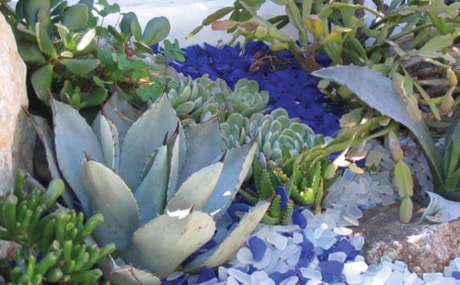SAN FRANCISCO — Tucked in an odd-shaped parcel of port property between railroad tracks and cargo ships sits a slice of inspiration.
At the Red Shovel Glass Co., trash becomes treasure. Tons of discarded bottles, otherwise rejected by recyclers, find new life as brightly colored “stones,” perfect for paths and garden decoration.
Broken mirrors, unwanted doors and windows, chipped dishes and glass tabletops, fallen roof tiles, smashed flowerpots: All are reborn into polished pebbles.
Tumbled smooth, the finished products sparkle like gems in colors rare in nature but common in trash bins.
“All this stuff would otherwise end up in landfills,” explains Matthew Levesque, who oversees Building REsources and Red Shovel Glass Co., its recycled-glass offshoot.
This nonprofit operation grew out of materials that couldn’t otherwise be recycled. That includes an awful lot of colored or tempered glass.
Open to the public as a subsidiary of San Francisco Community Recyclers, Building REsources started about 15 years ago with building discards — doors, windows, plumbing and lighting fixtures, and other reusable castoffs — culled from San Francisco trash.
“This city is constantly rebuilding itself,” Levesque says. “We have no shortage of these materials.”
In a year, about 1,000 tons of material, including the glass, is diverted from landfills through Building REsources.
Levesque, a poet turned manager, found beauty in these everyday items and started playing around with ideas.
“I encourage everyone to have fun,” he says. “If you get a crazy idea, try it.”
On their repurposed oasis, he and his staff create whimsical gardens and sculptures of found items to inspire potential customers. All the plants are orphans, too, thrown out by former owners.
“This has a lot in common with poetry,” Levesque says during a tour of his gardens. “Poetry is very analogical. Something is like something else. Here, an old sink is like a flowerpot, so why not make it a flowerpot?”
Plastic foam packaging coated with stucco becomes a fantasy fishpond. Strips of fiberglass skylight form a curvy chandelier. Rusted gates turn into trellises. A toolbox and a truck axle resurface as a cactus box garden and a patio table.
When it came to a mountain of discarded blue vodka bottles about five years ago, Levesque had a poetic revelation. Why not polish the glass like agates and use it to pave paths?
“It was another aha! moment,” he recalls.
And Red Shovel Glass Co. was born. But besides the product, these inventive recyclers had to come up with a way to make it.
“There’s no source for recycled bottle polishers in the phone book,” he says. “We had to come up with our equipment, too. And we wanted to make it as energy-efficient as possible. And do it without a budget. Then, I saw a cement truck drive by — and the idea light went on again.”
“It reminds me of glass I used to pick up on the beach at Lake Erie,” says technician Jennifer “Angel” Gurgovits, a longtime artist and Red Shovel’s tumbling master.
“It’s smooth from the waves and so pretty.”
Different glass and materials turn into distinctive final products. Glass tabletops make up larger light-blue “River Rocks.” Tempered glass doors and windows make cubelike pale-blue crystals. Wine bottles go into the olive-green “Chardonnay.”
“I like the Beach Blend,” she says as she fingers a barrel of glass in rainbow hues. “This started with broken glass swept off our floor. All these random things you find are in this mix.”
Much of the material comes from alcohol bottles and architectural glass. Art glass comes from glass-blowing studios.
(Debbie Arrington can be reached at darrington(at)sacbee.com.)
(Distributed by Scripps Howard News Service, www.scrippsnews.com.)
